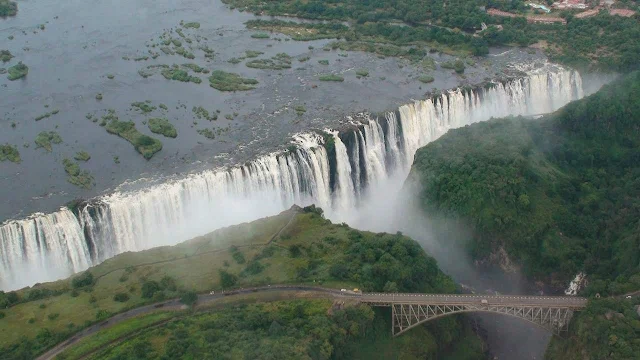Victoria Falls: Facts About Victoria Falls
Victoria Falls, located on the border between Zambia and Zimbabwe in Southern Africa, is one of the most spectacular and famous waterfalls in the world.
The main falls lie within Mosi-oa-Tunya National Park on the Zambian side and Victoria Falls National Park on the Zimbabwean side. Here are some interesting facts about Victoria Falls:
1-Largest waterfall in the world: While not the tallest or widest waterfall, Victoria Falls is the largest based on the combined width of 5,600 feet (1,708 meters) and the height of 354 feet (108 meters). That's more than twice the height of Niagara Falls! Victoria Falls also is the largest waterfall in the world by volume, with an average flow rate of 1,088 cubic meters per second (38,400 cubic feet per second). That's enough water to fill an Olympic swimming pool every two seconds!
2-Geological Formation: Victoria Falls Formed ~180 million years ago through volcanic activity, the resistant dolerite sill and underlying basalt lava flows provide the foundation for the falls. This dolerite forms the lip of the falls, while the underlying rock is comprised of basalt. 15 million years ago, tectonic movements merged rivers, channeling their combined flow through the basalt plateau.The river exploited softer rock layers beneath the basalt, widening fissures over millennia to form the falls. Erosion constantly reshapes the falls, currently receding upstream at 1.8m per year, carving the 350m-deep gorge and iconic horseshoe shape.
3-Name: The falls were named after Queen Victoria by the Scottish explorer David Livingstone in 1855. The local name for the falls is "Mosi-oa-Tunya," which means "the smoke that thunders." This name is fitting, as the spray from the falls can be seen from up to 40 kilometers away!
4-The falls are a UNESCO World Heritage Site and one of the Seven Natural
Wonders of the World: Victoria Falls was designated as a UNESCO World
Heritage Site in 1989 in recognition of its exceptional natural beauty
and geological significance.
5-Cultural Significance: The falls hold immense cultural importance for the indigenous communities of Zambia and Zimbabwe. They are considered sacred sites, featuring in local mythology and folklore.
6-Economic Impact: Victoria Falls is a major tourist attraction, generating significant revenue for both Zambia and Zimbabwe. The falls contribute to the development of infrastructure and tourism-related industries, creating jobs and promoting economic growth in the region.
7-Hydropower Generation: The falls serve as a vital source of hydroelectric power for both Zambia and Zimbabwe, harnessing the immense energy of the cascading water for sustainable electricity generation.
8-Film and Cultural Depiction: The grandeur of Victoria Falls has graced the silver screen in numerous films, including "The Lion King," "Indiana Jones and the Temple of Doom," and "Angels & Demons," further solidifying its global recognition.
Victoria Falls is not only a natural wonder but also a popular tourist destination offering a combination of stunning landscapes and thrilling activities.



%20(1).webp)





